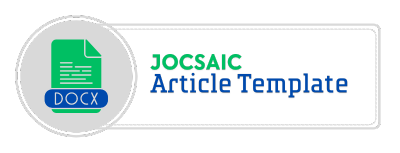Analysis of Historical Student Visit Data Using Time Series Algorithm
DOI:
https://doi.org/10.64803/jocsaic.v1i2.16Keywords:
Time Series,, Student Visit Data, Forecasting, ARIMA, Tren AnalysisAbstract
The analysis of historical student visit data plays a critical role in understanding student behavior, optimizing campus resources, and enhancing service delivery in educational institutions. This study presents an analytical approach to examine patterns and trends in student visitations using a time series algorithm. By leveraging historical datasets from campus access logs, we aim to identify periodic behaviors, peak visitation times, and anomalies that may reflect special events or system irregularities. The research employs time series methods such as moving average, exponential smoothing, and ARIMA (AutoRegressive Integrated Moving Average) to forecast future student visit patterns based on previous trends. Data preprocessing, normalization, and visualization techniques are applied to ensure data quality and interpretability. The results demonstrate that student visits tend to follow specific weekly and monthly patterns, with increased activity near academic deadlines or events. The ARIMA model, in particular, shows strong predictive accuracy with minimal error margin. This analysis not only provides insights for administrative planning—such as scheduling staff, managing facilities, or enhancing security—but also serves as a foundation for developing intelligent decision-support systems. In conclusion, applying time series algorithms to historical student visitation data proves effective in predicting future trends, thereby supporting data-driven decision-making processes within educational institutions.
Downloads
References
[1] L. A. Alexei and A. Alexei, “Cyber security threat analysis in higher education institutions as a result of distance learning,” Int. J. Sci. Technol. Res., no. 3, pp. 128–133, 2021.
[2] M. Hasanuddin, “Journal of Computer Science Artificial Intelligence Optimization of Computer Network Performance Using Heuristic Algorithms,” vol. 1, no. 1, pp. 12–17, 2024.
[3] A. Haleem, M. Javaid, M. A. Qadri, R. P. Singh, and R. Suman, “Artificial intelligence (AI) applications for marketing: A literature-based study,” Int. J. Intell. Networks, vol. 3, pp. 119–132, 2022.
[4] S. Khodijah, C. A. Rizki, and M. Hasanuddin, “Journal of Computer Science Artificial Intelligence,” vol. 1, no. 1, pp. 1–6, 2024.
[5] N. Kaniadewi, “The Analysis of Mandatory TOEFL Test Policy in University of Muhammadiyah Prof. Dr. Hamka.,” J. English Teach., vol. 9, no. 3, pp. 323–334, 2023.
[6] M. Hasanuddin, B. E. Susanto, S. Ginting, and F. Rizaldi, “Analisis Minat Siswa Kelas 1 SMK Pada Ekstrakulikuler Sepak Bola Dengan Metode Technology Acceptance Model,” vol. 4, no. 1, pp. 52–58, 2025.
[7] A. D. Smith, “Event detection in educational records: an application of big data approaches,” Int. J. Bus. Syst. Res., vol. 15, no. 3, pp. 271–291, 2021.
[8] M. Mariani and R. Baggio, “Big data and analytics in hospitality and tourism: a systematic literature review,” Int. J. Contemp. Hosp. Manag., vol. 34, no. 1, pp. 231–278, 2022.
[9] N. Khan, I. U. Haq, S. U. Khan, S. Rho, M. Y. Lee, and S. W. Baik, “DB-Net: A novel dilated CNN based multi-step forecasting model for power consumption in integrated local energy systems,” Int. J. Electr. Power Energy Syst., vol. 133, p. 107023, 2021.
[10] N. Elgendy, A. Elragal, and T. Päivärinta, “DECAS: a modern data-driven decision theory for big data and analytics,” J. Decis. Syst., vol. 31, no. 4, pp. 337–373, 2022.
[11] L. Amerta and I. Madhavi, “Exploring service quality and customer satisfaction in the service industry: A mixed-methods analysis,” J. Econ. Manag. Bus. Technol., vol. 2, no. 1, pp. 1–16, 2023.
[12] M. B. A. Rabbani et al., “A comparison between seasonal autoregressive integrated moving average (SARIMA) and exponential smoothing (ES) based on time series model for forecasting road accidents,” Arab. J. Sci. Eng., vol. 46, no. 11, pp. 11113–11138, 2021.
[13] S. K. Safi and O. I. Sanusi, “A hybrid of artificial neural network, exponential smoothing, and ARIMA models for COVID-19 time series forecasting,” Model Assist. Stat. Appl., vol. 16, no. 1, pp. 25–35, 2021.
[14] B. Hansen, J. J. Sabia, and J. Schaller, “In-person schooling and youth suicide: Evidence from school calendars and pandemic school closures,” J. Hum. Resour., vol. 59, no. S, pp. S227–S255, 2024.
[15] J. Baldoni, Grace Under Pressure: Leading Through Change and Crisis. Savio Republic, 2023.
Downloads
Published
Issue
Section
License
Copyright (c) 2024 Sri Ramadhany, Sahara Abdy, Alfiarini (Author)

This work is licensed under a Creative Commons Attribution-ShareAlike 4.0 International License.









